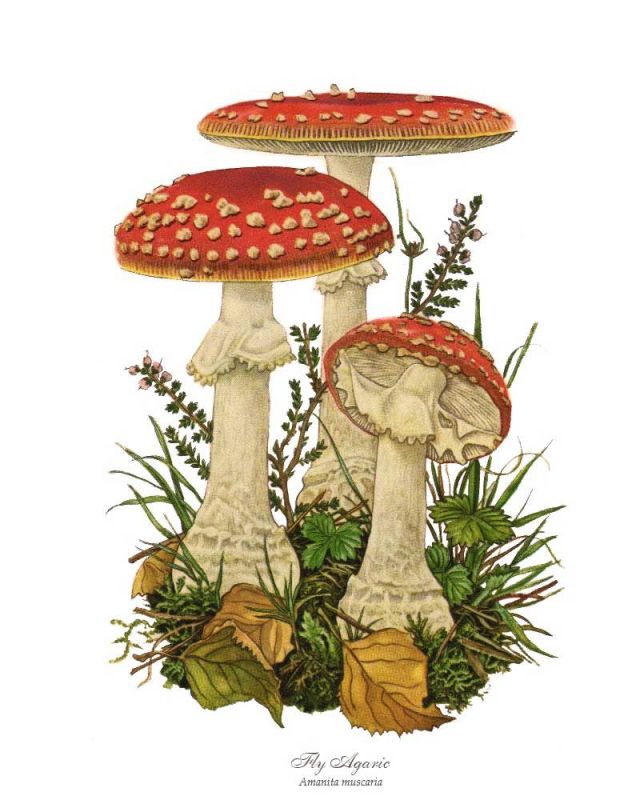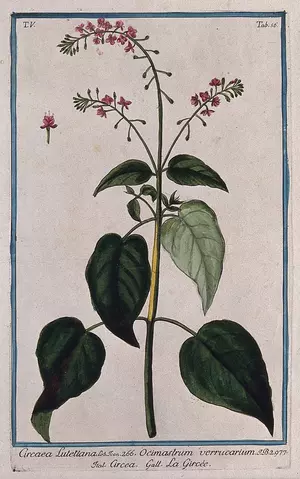
It is that time of the year again, the wheel has turned and nothing quite lights up the forest floor the way that Fly Agaric does. With its bright red caps, it summons feelings of childhood fairy tales and wonder. Amanita Muscaria, also known as Fly Agaric or Fly Amanita, is the most recognisable mushroom in the world. Famed for its vibrant red cap dotted with white spots. Beyond its striking appearance, the Fly Agaric has played a prominent role in folklore, traditional medicine, and mystical practices across many cultures.
Both deadly and intoxicating, this mushroom holds a special place in the hearts of many. Let us look at identifying these wonderful mushrooms before moving on to their history and uses.
Identifying Fly Agaric

As mentioned above, Fly Agaric has a distinctive red cap with white spots, although the shade can differ. Some specimens can range from scarlet to orange, and they tend to lose the white spots as they age. The gills are varied between white and cream and are tightly packed but not joined to the stem. The stem is white with a brittle texture and tends to be bulbus at the bottom. Fly Agaric can grow to over 30cm in height and 20cm across and typically appear in late summer to early winter. These plants thrive in woodland and heathland settings with light soil, especially where Birch, Pine, or Spruce trees are present. [1]
Historical Overview
The Fly Agaric has a rich and varied history spanning Europe, Asia, and beyond. Its image has been immortalised in fairy tales, artwork, and even modern media, often associated with enchanted forests and mythical beings. For more than 10,000 years, especially throughout Asia, it has played a role in religious ceremonies. In India and Iran, it was used to create a hallucinogenic drink called “Soma,” while Siberian shamans would gift it to people in late December [2].
One of these rituals, performed during the Siberian midwinter festival of Annual Renewal, saw a shaman gather these mushrooms from under trees while wearing a red coat with white fur trim and long black boots. The shaman would then enter the yurt through a hole in the roof and slide down the central support pole, normally made of birch, bringing with him a bag of dried Fly Agaric [3]. Could this be the origins of the Father Christmas mythos? Possibly. But a much more likely reason comes from Reindeer urine.
You see, if you eat the Fly Agaric without preparing it in the correct way you leave yourself open to side effects – mostly sickness, but death is possible, if exceedingly rare. The Sami people realised that by drinking the urine of the Reindeer, they could experience the hallucinatory effects without the side effects. The heightened effects caused by these mushrooms can produce visions of flying, resulting in some Sami person seeing Reindeer flying [4].
Beyond Father Christmas, Fly Agaric has influenced stories such as Alice in Wonderland and even how Viking fought in battle.
The reason the Fly Agaric has played such a significant role in history comes down to two important chemicals that it produces, ibotenic acid and muscimol. When ingested, these chemicals create the hallucinogenic effect spoken about above [5].
The name “Fly Agaric” comes from its traditional European use as an insect killer, where people would break up the mushrooms into milk to lure and eliminate flies. The species name “muscaria” also alludes to its fly-attracting properties [6].
Toxicity

The Fly Agaric (Amanita Muscaria) is an extremely toxic mushroom that should only be handled by expert mushroom hunters. Ingestion usually impacts the central nervous system most significantly, acting as either a sedative or exciter. Symptoms of ingestion can include nausea, vomiting, confusion. In severe cases ingestion can cause seizures or coma. Death from the mushroom is rare, but does happen [7]
Medical Uses
Despite its reputation as a poisonous mushroom very few deaths have occurred because of consuming it. Fly Agaric was cautiously employed in traditional medicine. The mushroom contains muscimol and ibotenic acid, which may cause hallucinations, changes in perception, and sometimes toxicity. Drying Fly Agaric and then brewing it as a tea by boiling it in water can help reduce its toxicity [8].
Fly Agaric’s active compound, muscimol, is known to act on the brain’s GABAergic system. Modern studies have shown a potential role for this compound in treating pain, inflammation, anxiety, cognitive decline, and cancer [9]. This research is still in its infancy and modern medicine does not advocate the use of Fly Agaric due to its unpredictable effects and the potential for poisoning.
In the past, Fly Agaric was commonly utilised in traditional remedies to treat various health issues. Locating dependable sources has proven difficult; however, certain references suggest its application as an analgesic, especially for alleviating joint and muscle pain. It has also been used to treat anxiety, insomnia, and even as a topical application for frostbite and other skin conditions.
Magical Uses

No mushroom brings about images of the Fae then the Fly Agaric, synonymous with illustrations in children’s books. It is connection to the fae, to the Birch, Pine and Cedar trees, invites us to ground and work with the energies of the earth.
The power that these mushroom holds, both mystically and chemically, make this a plant ally that is not for the beginner. A cautious approach is needed to ensure that both practitioner and spirits are safe.
Halloween, Samhain, Nos Calan Gaeaf, whatever you call it, is a time of liminality and it is no coincidence that the Fly Agaric is at its most striking. The mind-altering effects of these mushrooms, combined with the knowledge of tropane alkaloids found in species of plants such as deadly nightshade (Tropa Belladonna) and Henbane (Hyoscyamus Niger) where used by British witches.
These cleaver witches quickly discovered that making these plant compounds into a salve made for a more potent and pleasurable application. The first known mention of these balms appears in the investigation records related to Lady Alice Kyteler. In 1324, Alice, a noted English witch, was accused of poisoning multiple husbands [10]. Scott Cunningham also lists her as an ingredient in Flying Ointment.
In Western esoteric traditions, Fly Agaric is associated with themes of transformation, altered perception, and liminality. It is often featured in contemporary magical practices as a symbol of the gateway between worlds, though actual consumption is discouraged due to safety concerns discussed above.
There is also an association between Fly Agaric and the Irish goddess Brigid that survived the Christianisation of the country [11]. Some suggest that dried mushrooms may have been used during Imbolc to inspire poets and bards.
Conclusion
The Fly Agaric continues to keep humans enchanted by its beautiful colours and mythical associations. Prised for its ability to both thin the veil and send you through it if you are not careful. It continues to grace the pages of our children’s books and holds promising potential as a medicine in the future. I think you will agree that this is a top tier mushroom and all-round fungi to be with.
Sources
[1] https://www.woodlandtrust.org.uk/trees-woods-and-wildlife/fungi-and-lichens/fly-agaric/
[2] ibid
[3] https://www.bbcwildlife.org.uk/blog/james-benwell/fungi-folklore-and-christmas-how-fly-agarics-shaped-our-festive-season
[4] ibid
[5] https://www.compoundchem.com/2024/11/11/fly-agaric/
[6] https://www.woodlandtrust.org.uk/trees-woods-and-wildlife/fungi-and-lichens/fly-agaric/
[7] https://pmc.ncbi.nlm.nih.gov/articles/PMC7977045/
[8] https://foragerchef.com/amanita-muscariafly-agaric/
[9] https://www.researchgate.net/publication/345154633_Fly_Agaric_as_Medicine_From_Traditional_to_Modern_Use
[10] https://en.wikipedia.org/wiki/Alice_Kyteler
[11] https://akjournals.com/view/journals/2054/6/1/article-p1.xml
Discover more from The Scouse Druid
Subscribe to get the latest posts sent to your email.




Very educational, I’m not well versed in the properties of the flora around us. I enjoy it’s company but am sadly ignorant as to its properties and history. Thank you.
Your very welcome.